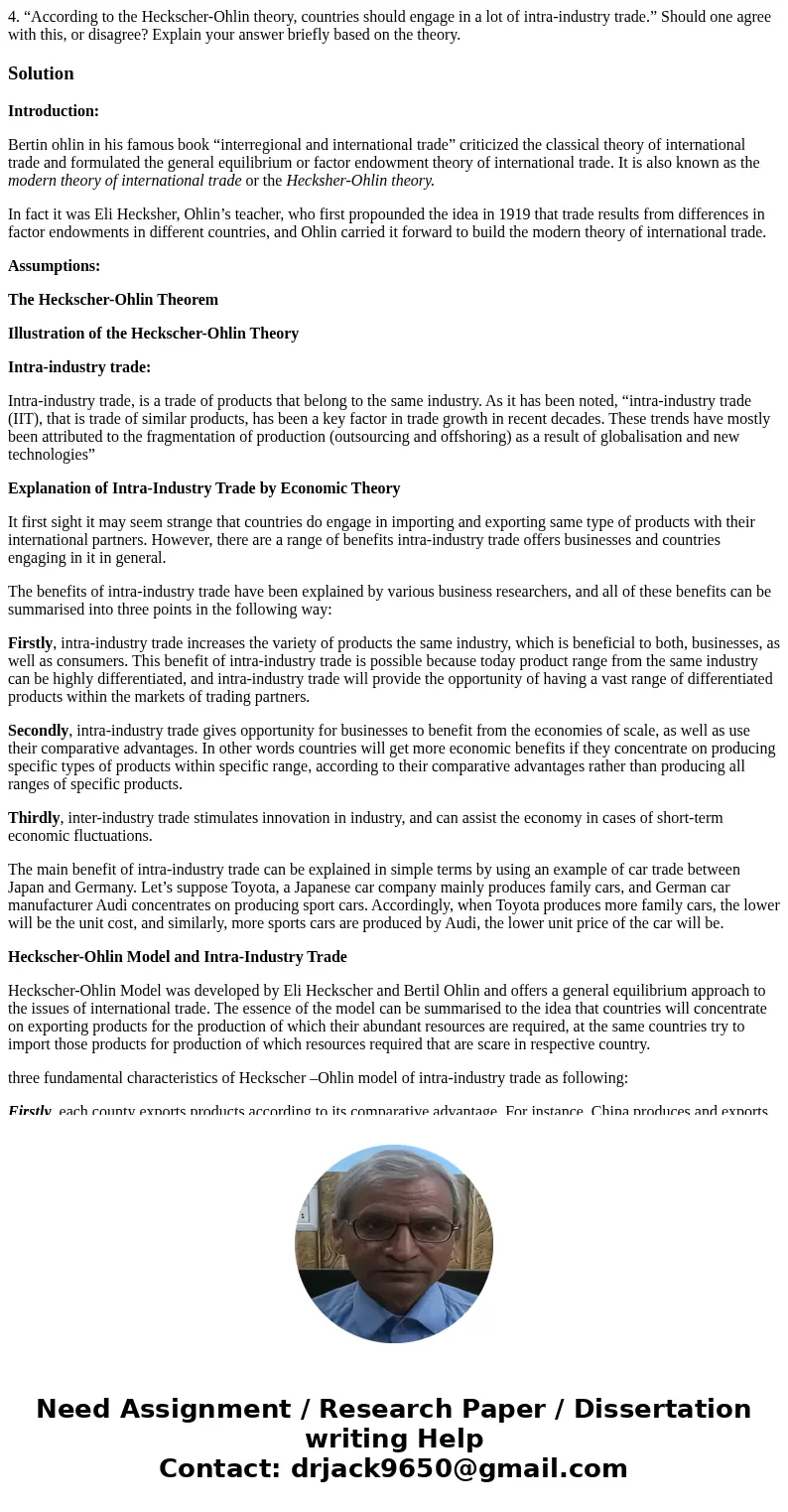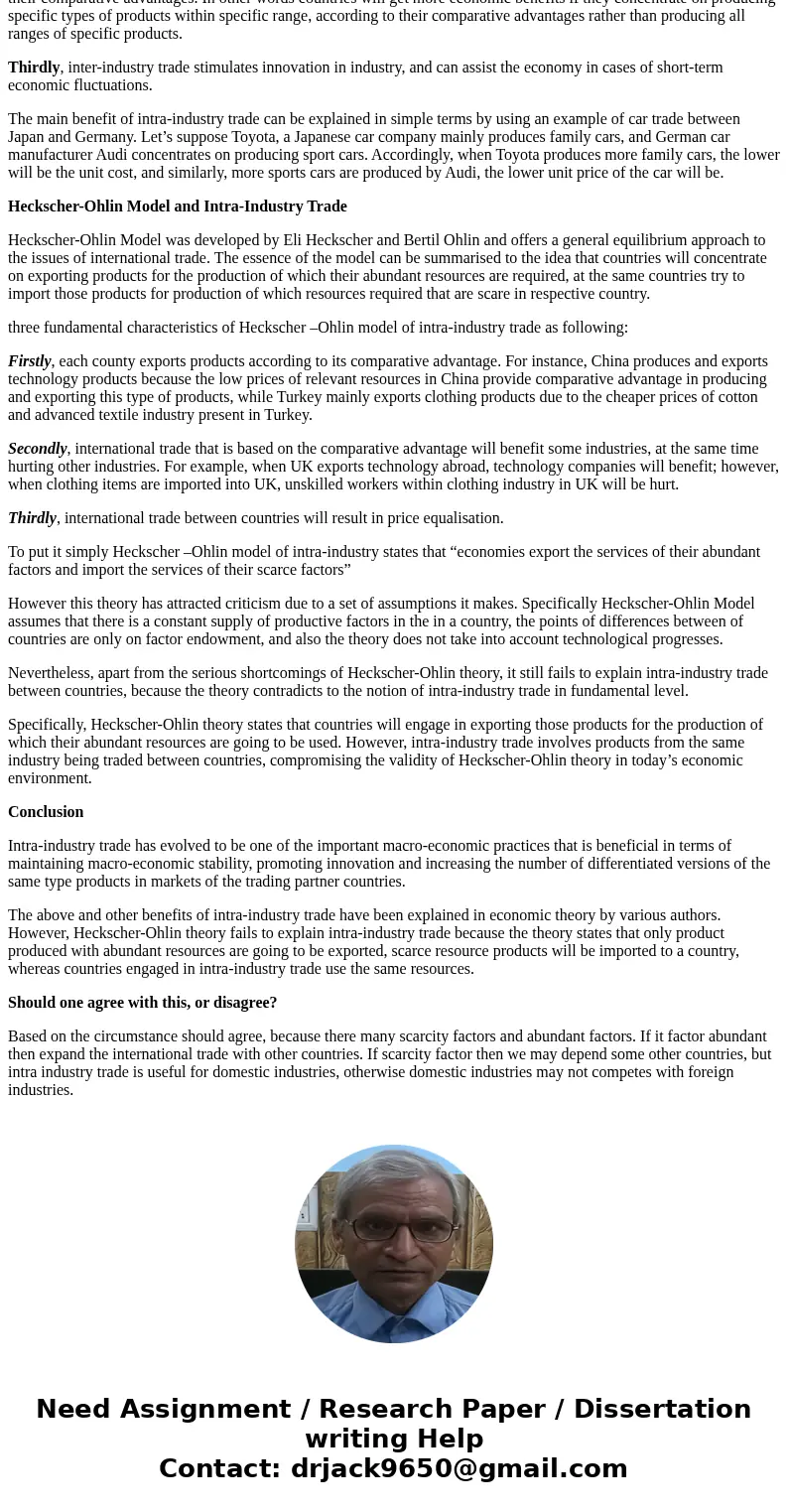4 According to the HeckscherOhlin theory countries should en
4. “According to the Heckscher-Ohlin theory, countries should engage in a lot of intra-industry trade.” Should one agree with this, or disagree? Explain your answer briefly based on the theory.
Solution
Introduction:
Bertin ohlin in his famous book “interregional and international trade” criticized the classical theory of international trade and formulated the general equilibrium or factor endowment theory of international trade. It is also known as the modern theory of international trade or the Hecksher-Ohlin theory.
In fact it was Eli Hecksher, Ohlin’s teacher, who first propounded the idea in 1919 that trade results from differences in factor endowments in different countries, and Ohlin carried it forward to build the modern theory of international trade.
Assumptions:
The Heckscher-Ohlin Theorem
Illustration of the Heckscher-Ohlin Theory
Intra-industry trade:
Intra-industry trade, is a trade of products that belong to the same industry. As it has been noted, “intra-industry trade (IIT), that is trade of similar products, has been a key factor in trade growth in recent decades. These trends have mostly been attributed to the fragmentation of production (outsourcing and offshoring) as a result of globalisation and new technologies”
Explanation of Intra-Industry Trade by Economic Theory
It first sight it may seem strange that countries do engage in importing and exporting same type of products with their international partners. However, there are a range of benefits intra-industry trade offers businesses and countries engaging in it in general.
The benefits of intra-industry trade have been explained by various business researchers, and all of these benefits can be summarised into three points in the following way:
Firstly, intra-industry trade increases the variety of products the same industry, which is beneficial to both, businesses, as well as consumers. This benefit of intra-industry trade is possible because today product range from the same industry can be highly differentiated, and intra-industry trade will provide the opportunity of having a vast range of differentiated products within the markets of trading partners.
Secondly, intra-industry trade gives opportunity for businesses to benefit from the economies of scale, as well as use their comparative advantages. In other words countries will get more economic benefits if they concentrate on producing specific types of products within specific range, according to their comparative advantages rather than producing all ranges of specific products.
Thirdly, inter-industry trade stimulates innovation in industry, and can assist the economy in cases of short-term economic fluctuations.
The main benefit of intra-industry trade can be explained in simple terms by using an example of car trade between Japan and Germany. Let’s suppose Toyota, a Japanese car company mainly produces family cars, and German car manufacturer Audi concentrates on producing sport cars. Accordingly, when Toyota produces more family cars, the lower will be the unit cost, and similarly, more sports cars are produced by Audi, the lower unit price of the car will be.
Heckscher-Ohlin Model and Intra-Industry Trade
Heckscher-Ohlin Model was developed by Eli Heckscher and Bertil Ohlin and offers a general equilibrium approach to the issues of international trade. The essence of the model can be summarised to the idea that countries will concentrate on exporting products for the production of which their abundant resources are required, at the same countries try to import those products for production of which resources required that are scare in respective country.
three fundamental characteristics of Heckscher –Ohlin model of intra-industry trade as following:
Firstly, each county exports products according to its comparative advantage. For instance, China produces and exports technology products because the low prices of relevant resources in China provide comparative advantage in producing and exporting this type of products, while Turkey mainly exports clothing products due to the cheaper prices of cotton and advanced textile industry present in Turkey.
Secondly, international trade that is based on the comparative advantage will benefit some industries, at the same time hurting other industries. For example, when UK exports technology abroad, technology companies will benefit; however, when clothing items are imported into UK, unskilled workers within clothing industry in UK will be hurt.
Thirdly, international trade between countries will result in price equalisation.
To put it simply Heckscher –Ohlin model of intra-industry states that “economies export the services of their abundant factors and import the services of their scarce factors”
However this theory has attracted criticism due to a set of assumptions it makes. Specifically Heckscher-Ohlin Model assumes that there is a constant supply of productive factors in the in a country, the points of differences between of countries are only on factor endowment, and also the theory does not take into account technological progresses.
Nevertheless, apart from the serious shortcomings of Heckscher-Ohlin theory, it still fails to explain intra-industry trade between countries, because the theory contradicts to the notion of intra-industry trade in fundamental level.
Specifically, Heckscher-Ohlin theory states that countries will engage in exporting those products for the production of which their abundant resources are going to be used. However, intra-industry trade involves products from the same industry being traded between countries, compromising the validity of Heckscher-Ohlin theory in today’s economic environment.
Conclusion
Intra-industry trade has evolved to be one of the important macro-economic practices that is beneficial in terms of maintaining macro-economic stability, promoting innovation and increasing the number of differentiated versions of the same type products in markets of the trading partner countries.
The above and other benefits of intra-industry trade have been explained in economic theory by various authors. However, Heckscher-Ohlin theory fails to explain intra-industry trade because the theory states that only product produced with abundant resources are going to be exported, scarce resource products will be imported to a country, whereas countries engaged in intra-industry trade use the same resources.
Should one agree with this, or disagree?
Based on the circumstance should agree, because there many scarcity factors and abundant factors. If it factor abundant then expand the international trade with other countries. If scarcity factor then we may depend some other countries, but intra industry trade is useful for domestic industries, otherwise domestic industries may not competes with foreign industries.


 Homework Sourse
Homework Sourse